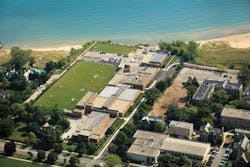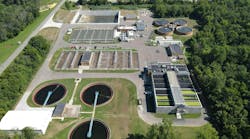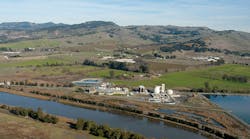The Evanston Water Treatment Plant and the city of Evanston, Ill., are like love and marriage in the Frank Sinatra song: You can’t have one without the other.
The plant, which originally was developed for firefighting purposes after the Great Chicago Fire of 1871, not only provided Evanston with some insurance against fire damage, but it also brought disparate municipalities together to form the city.
“The water plant helped create Evanston, because, at that time, there were actually three Evanstons—there was south Evanston, the city of Evanston and north Evanston,” said Dave Stoneback, director of the Evanston Public Works Agency. “Each little area was too small and did not have enough taxing body to be able to build a plant.”
Together, the three Evanstons were able to construct the plant—at that time a communal water system with two steam engines, a boiler and cast iron water main.
In 1914, Evanston built a 12-million-gal-per-day (mgd) filter plant containing six rapid sand filters on the shores of Lake Michigan. Ten years later, the plant doubled its filtration capacity. In 1944, Evanston added the nearby community of Skokie as a wholesale water supplier, necessitating a large plant expansion in 1948, which added an all-electric high lift pumping station—until that point, the plant had been coal-powered—as well as new chemical treatment systems, filters, settling basins and flow mix basins.
The plant now has 24 filters and a capacity of 108 mgd. It serves approximately 360,000 people, including residents of Evanston, Skokie, and the northwest suburbs of Arlington Heights, Buffalo Grove, Palatine and Wheeling, for a total service area of 66.2 sq mi.
Treatment Processes
The Evanston Water Treatment Plant draws water from Lake Michigan through three large intake pipes along the lake bottom. The water flows into three suction wells through screens that remove trash. Six low lift centrifugal pumps lift the water so it can flow by gravity through the plant.
Once in the plant, water enters a flash mix basin where liquid aluminum sulfate, chlorine and fluoride are added. Aluminum sulfate forms floc in the water, chlorine disinfects and oxidizes, and fluoride prevents water drinkers’ teeth from decaying. The water moves on to six slow mix basins and then into four large settling basins. Over four to eight hours, it flows through the basins and floc settles out. From there, the water flows to the rapid sand filters. A detention tank collects filter wash water for cleaning the filters when they clog and recycles it back into the incoming raw water. The rest of the water flows into clear well reservoirs and an underground storage space, which together hold 9.5 million gal of reserve water. Nine high lift pumps supply water pressure to the distribution system.
Though its system is conventional for a water treatment plant, according to Stoneback, two criteria differentiate the Evanston plant from others in the area. The first of these is its size: exempting the large plants in Chicago and Milwaukee, “most other plants along Lake Michigan, at least in Illinois and Wisconsin, are more in the range of 20 to 40 mgd,” Stoneback said. Evanston is also one of few plants to employ distributed generators on its low lift pumps. “In a lot of other plants, they have one great big generator. If that fails, the whole plant stays out,” Stoneback said. The Evanston plant has operated for three days solely off the natural gas engines on the low lift pumps.
Recent Refinements
The plant has encountered some interesting predicaments over the years. In 1992, it installed a chlorine feed system to control invasive zebra mussels. In 2009, it added a heated intake system to counter the phenomenon of “anchor ice”—when ice forms at the bottom of Lake Michigan during cold, windy nights, enters intake pipe and creates “snow cones” that shut off flow to the plant.
The plant’s latest battle is coping with the Illinois Department of Natural Resources’ (IDNR) stringent water treatment requirements. IDNR has implemented a new standard for non-revenue water, or water lost before it reaches customers through leaks or metering inaccuracies. The standard is “much more strict, so we’re trying to make improvements to be able to measure the water that we’re sending out of the treatment plant more accurately,” Stoneback said.
Other recent improvements include an overhaul of the plant’s SCADA system and upgrades to its chlorine feed equipment. Chemical feed improvements and replacing a structurally unsound 1934 clear well are on the agenda.
Download: Here


